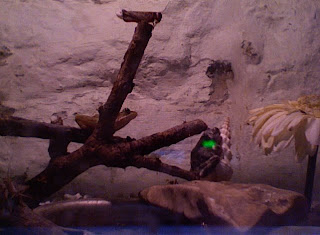an afternoon at the neighborhood park.
STOP looking at your computer GO
|| Innocence ||
an afternoon at the neighborhood park.
|| Midwestern Sunsets ||
| Midwestern Renaissance |
|| Fancy ||
|| Fleuri ||
| un Bleus film |
Cinema Is. ~ An Essay.
Preamble
The following is an essay.
This is not a proper entrance
essay. I will now type the word 'essay' again.
Then the word repetition. 'Repetition'. Remember.
Belief is the mere spark of desire.
WHY CINEMA?
The reason cinema swoons us is its presentation of a world without us. Cinema has a life, essentially separate from our own, which lures us into the experiences of others. Such chemistry between cinema & its audience creates a bond which, if the film is effective, not only has the ability to stay with viewers for hours if not days afterward - haunting each participant with memorable provocative notions - it has the power to stay with a viewer for an entire lifetime.
“What you can't tolerate, you can't tolerate in images either. An image is just as compromising, since it stands for you”
Cinema gives birth only to saints, beasts, & cripples.
These graceful saints & resourceful beasts propagate progressive ideas & bear the scrutiny of mass-consumption, & therefore become timeless. Cripples are the majority, incontinent & slobbering, begging to be fed, gasping for acceptance. Unable to stand the scrutiny, natural selection sets in. Yet the regressive cripples succeed in numbing the mass-consciousness. They are Narcissus in a contagious reflection, proliferating certain inhuman stereotypes with unrealistic ideals & attitudes toward life & other people.
Despite predominant dumbed-down films, there is always the potential for The Thin Blue Line or The People vs. Paul Crump, which commuted men from their death sentences. Such an example is reason enough to pursue a vocation in the craft of moving images, to utilize it as an instrument of social change. Cinema as a cure for misanthropy, xenophobia, et al. For to change the way we see ourselves is an echelon of a noble action. Or is it?
A man in Los Angeles claimed after seeing Catch Me If You Can he set to work on becoming a fake airline pilot the next day. He spent New Years Eve 2003 in jail for causing a public disturbance when he was caught trying to board the plane. He said the movie had “inspired” him. If only for a short time, our own beasts & saints are brought out through such inspirations. Beasts skewer our comfortable daily viewpoints in such a maddening writhe we forget who we were before seeing it. Saints, eking unexpectedly, often require great patience. Saints are merely beasts of impenetrable tranquility. The cripples leftover sit stunted in thought, misapprehending all they see.
WHY CINEMA?
Because of a desire to influence generations to be more humane than all those past.
To get people to think larger than themselves. To educate the uneducated.
WHAT CINEMA?
Forced unoriginality has become the norm.
“Systematically lowered standards”
This is the American sitcom laugh-track, demanding reactions, invoking fear of social acceptance. 'Everyone else is laughing, why aren't you?' Adam Curtis' The Century of the Self helps outline how & why there is manipulation in our cinemas. Luckily, not all filmmakers are so susceptible or venal.
Some have noticed a recent shift in French cinema around the turn of the century. An uncorroborated movement which, for lack of a more concise phrase, could be referred to as 'minimalist extremism'. Its formative tenets are most apparent in its female directors. The resounding pillars being Claire Denis & Catherine Breillat, both born in 1948 & contributing to cinema for the last thirty-odd years. Fellow Frenchman Bruno Dumont & Austrian Michael Haneke have each taken cues from these two pillars, at turns introspective, voyeuristic, & transgressive. Reverberations of the long-lasting effects of Rivette & Pasolini which blare out polarities. However, with M. Denis the word 'extremism' is meant in an entirely different context than the carnal. Rather than the presentation of humane underlurkings & visceral thresholds (often with an unexpected brutal climax, used as a valuable mnemonic effect) to which these other directors often attest, Denis works on a far heavier scale. In a fine-tuned way, Beau Travail & L'Intrus show that tone surpasses the efficiency of any plot. Or at least:
Tone limits any story's effectiveness. This principle is true of all Hitchcock. No matter how dense his plot stands, it is only as effective as the series of tones he prescribes to each sequence. The same principle cannot be applied to all cinematic work. Those which eschew plot cannot be held to the same standard as those whose goal is to tell an engaging story. For example, impressionistic documentaries (comme Koyaanisqatsi, Phantom India, ou Antonio Gaudí) are exempt from such a scale.
The scale is one of perspective. Weighted in probabilities. Accuracies. The psychopath is a human of incredible reason. The child, all sights are wonders. The lovers balance hope & doubt. The presentation of mood through pacing, composition & tableaux generate viewer responses to coincide with given perspectives.
Believability is governed by tone.
WHAT CINEMA?
That which enables a viewer to accept a given perspective as authentic & effectual.
The cinema which provokes thought by changing our perspective.
BUT HOW?
Remind people that cinema is ubiquitous. Every dream is cinema. Every horseride. Every working microwave. Remember the view out your window is always cinema.
HOW CINEMA?
Cinema has not yet reached its fullest potential.
Most are cozily stuck in the ways known to work to even consider attempting to bend & break its many formulas. There may be a few fauves left, a few Brechtian provocateurs, yet cinema has not grown into its fullest possible medium. Few beacons of light are left. American cinema has stumbled, been stunted, even placid, for decades. The creative innocence of 'Hollywood's Golden Age' has longsince been corrupted. The norm is watered-down en masse. Underhanded, this distillation is dishonest. To be true to cinema one must use its malleability to create new & increasingly engaging forms. Much has been left undone. To break the conventions, to use innovation, is to utilize cinema. We must progress the form. We must change not only the way people see cinema, but how it is shown. In foresight create new ways of watching. Imagine not a movie theatre or television but a hologram generating a micro-thin rectangle with seemingly pitch-perfect visuals. The word rectangle was used.
This is the recognizable to conventional cinema. A much simpler but more superficial way of progressing form, rather than improbably hope for hologram technology, could be to abandon this idea of 16:9 widescreen as the preferred canvass. Finding exemplars for using the 4:3 full-screen are easy (Citizen Kane). But why bother with rectangles? Because of tradition? Why not a film concept that utilizes a circle canvass? Or a triangle? Or a film about a maze in the shape of a heptagon? Who's to say it's not aesthetic? What about a series of films projected on a 3-dimensional undecahedron? Who's to say it's impossible? We must challenge such ideas with experimentation. For the art of using tangible film, celluloid itself, has long been dying. It is a future fact that there will be no more filmmakers – only digital moviemakers, cinemamakers. One should be so lucky to use 65mm & 70mm filmstock before it's all gone. If one is to compose in a rectangle canvass, it ought to fit a whole lot of Earth in the frame.
Claire Denis summed up the feeling of excitement in the production phase, saying: “During filming... there are moments when you have the right not to reply & to let things happen. Before the shoot, after the shoot, you have to account for everything.” When we are not lost in the love of capturing images, responsibility sets in. It has been said that a film can be edited wrong a billion different ways, & that there may only be a hundred, or a few dozen ways of getting it right. As preproduction allows imaginative vision to take root, postproduction enables proficiency of the form. Like a verb, montage is an infinitive game. We utilize editing to bind varying subjects & tenses.
In the trailer for Vérités et Mensonges, Orson Welles intones, “This lady, does she know more than she's telling? Or is she telling more than she knows?” This is both the essential paradigm of cinema, as well as its own romantic paradox. Tugging the question: How can we give the most accurate & honest depiction of the feeling of being alive, if by filming we are interfering & therefore influencing life's natural state?
Only interpretation knows.
|| It's Real ||
|| C'est Vrai ||





